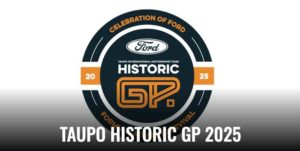The 150mph Ford RS200 is a mid- engined two- seater sports car whose state of the art designed features many advanced concepts. They include a driver selectable four or two-wheel drive transmission for competition version), high-technology lightweight materials for the chassis and body panels, and a 50/50 weight distribution for optimum handling.
The RS200 spearheaded Ford’s return to international motor sport. Only 200 were built to comply with the Federation Internationale de l’ Automobile’s Group B homologation rules. But the car’s turbocharged, 16 valve, fuel injected engine, unique driveline and advanced chassis also provide exceptionally high levels of road performance for a very small number of people who will automatically become members of the exclusive Ford 200 club.
Developed by For Motorsport engineers in conjunction with Tony Southgate, an engineer with extensive Formula One and sports car design experience Ford’s most exciting sports car since the GT40 is powered by a 1.8-litre 4 cylinder twin overhead Camshaft, 16 valve engine developed by Ford from the classic Cosworth BDA design.
Its inherent high efficiency is optimised by a Garrett AiResearch TO3/4 turbocharger with a roof-mounted intercooler.
Electronic fuel injection and ignition are controlled by Ford’s EEC IV microprocessor – the world’s most advanced engine management system – which can handle up to one million commands a second. The ‘black box’ matches fuel and spark characteristics to every combination of speed and load, from cold starts and tick over at the traffic lights to full-throttle acceleration and maximum power on a rally stage.
The ‘standard’ version of the BDT engine develops 250 PS at 6000 rpm, allowing the RS200 to accelerate from zero to 60mph in less than five seconds. Higher turbocharger boost and other modifications increase the robust power unit’s output to approximately 420 PS for competition purposes.
Conditions on rally stages vary from ice, snow and gravel, where four-wheel drive is essential for maximum traction, to high-friction tarmac on which rear-wheel-drive cars are quicker. All conditions demand a very agile, responsive and sure-footed design capable of fast directional changes. Specified with eight-spoke Speedline alloy wheels and fitted with 225/50VR16 Pirelli tyres, Ford’s RS200 meets those key requirements with its mid-engine, front mounted transaxle layout, 50/50 weight distribution and a best-of-both worlds transmission which enables four-wheel drive, rear-wheel drive, or locked centre differential, to be selected at speed (on competition version).
Each of the transmission’s three limited-slip differentials is of the latest Viscous-control type. Their silicone fluid provides a progressive, wheel-spin sensitive system which eliminates the traditional limited-slip differential’s relatively harsh engagement.
When four-wheel drive is selected, 37 percent of the engine’s torque goes to the front wheels and 63 per cent to the back. The split gives the best balance for maximum traction and optimum handling under dynamic conditions.
Although designed with competition in mind, the system’s versatility gives road versions of the RS 200 phenomenal all-weather handling and traction. It represents a link between Ford Motorsport and FF Developments, the company whose knowledge of four-wheel drive is based on more than 45 years experience.
The RS200’s body/chassis is essentially a space-age combination of advanced materials and composite construction techniques. Strong, safe and light, the chassis consists of a fully stressed platform reinforced by deep box sills, bulkheads and a central backbone moulding. The structure uses steel, aluminium honeycomb ‘sandwich’ and composite carbon/aramid/glass fibre reinforced panels.
Ease of servicing was a major design priority, particularly for competition work, and the whole driveline is readily accessible from underneath the car.
The RS200’s fully independent, adjustable suspension has double wishbones, twin coil spring telescopic damper units and anti-roll bars at front and rear and includes long wheel travel suitable for rally stage conditions. Other features include cast-aluminium upright and Formula One standard ventilated disc brakes all round.
The steering rack and column, like the windscreen and doors, are Sierra-based components.
Ford’s Ghia Design studio created the styling concept and worked with Ford’s design groups in Britain and Germany to perfect the smooth, functional, wedge-shaped body.
Lessons learned during wind tunnel tests in both countries enabled the Ford Design Centre at Dunton, Essex, to increase aerodynamic down force and to maximise cooling efficiency while avoiding significant drag penalties.
Provisions for mounting full, rally-size spare wheels at either end of the car enable weight distribution to b e trimmed for individual events. On the road version, the front spare’s position can be fitted with a detachable luggage compartment (Dealer option).
Attractive and practical, the cockpit layout follows Ford’s general concept of grouping instruments and equipment into function related panels. Essential instruments and controls in front of the driver are complemented by auxiliary gauges and supplementary switches in the centre of the two-seater.
Not all the RS200s were produced in Diamond White, there were several Red and Blue cars assembled, all in either right hand drive or left hand drive and with a choice of road or rally specifications. Both versions used the same engine, but some parts and mechanical components, such as shock absorbers, springs and mounting bushes would be changed on rally versions.
Built to win rallies and races the RS200 unfortunately had a very short life as the Group B rally car, it was banned. But the RS200 went on to become a very dominant vehicle in the world of rally cross.
